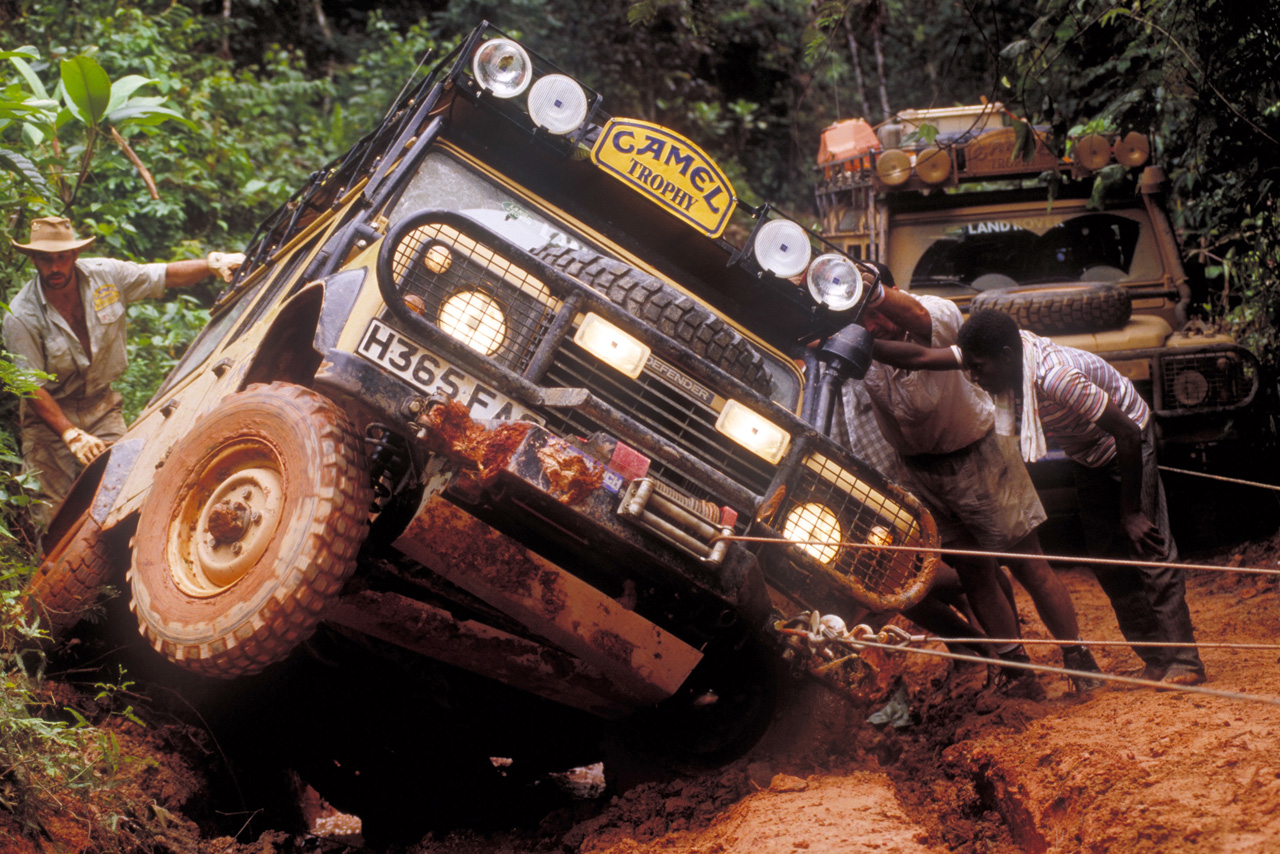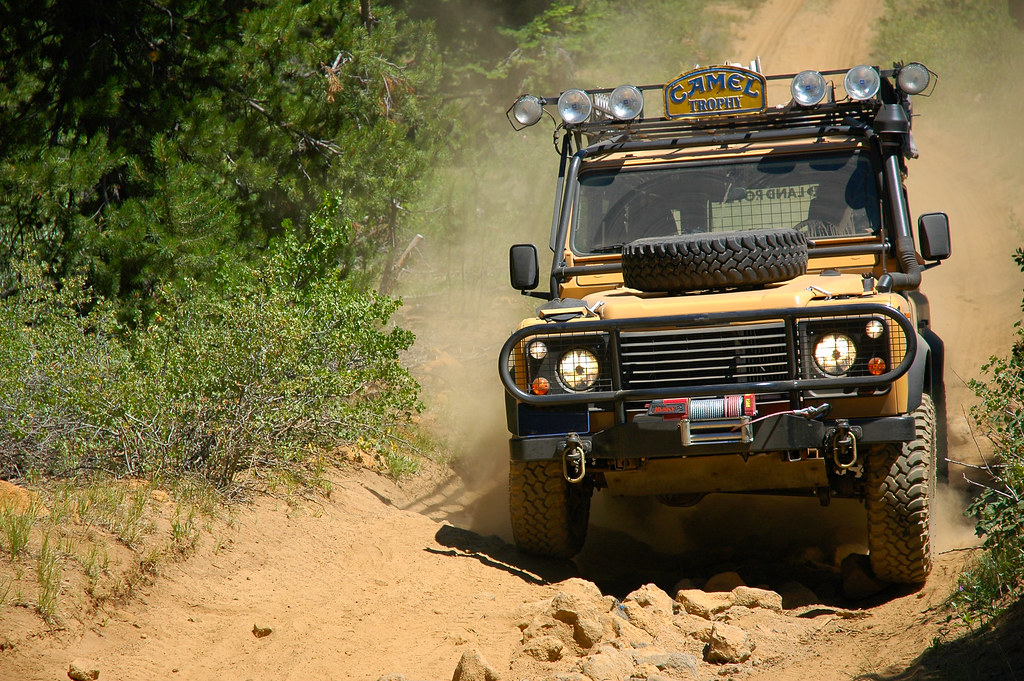Camel Trophy
The Camel Trophy was a sort of car rally with expedition character. It was launched in 1980 by the Camel cigarette brand and found every year in a different country. The idea was developed by the advertising agency in Düsseldorf Team / BBDO, copyright was Thomas Wulfes. The " endless adventure " ( as advertising ) led the participants who had to qualify each in their home countries. Transiting technically difficult terrain, mostly jungle regions It was not only on the skill of the SUV by the organizers, but also on the team spirit, the technical improvisation and perseverance of the participants. The Camel Trophy was discontinued in 1999.
The vehicles were initially jeeps, but later exclusively different types of the brand Land Rover were used. These were equipped by the manufacturer with extensive accessories such as auxiliary lights, auxiliary tanks, winches and measures for rollover protection. Each vehicle was occupied by two participants from one country to the last trophies participated up to 20 teams. For Land Rover, the Trophy was an important promotional tool to demonstrate the quality of their vehicles under extreme conditions, accordingly, the company was a major sponsor. After the expedition character of the Trophy had subsided in recent years, the company decided in 1999 to get out as the main sponsor. This had a significant influence on the setting of the Trophy by Worldwide Brands, the owner of the Camel brand.
Criticism of the Camel Trophy came from a number of serious rally driver and various environmental organizations. Apart from the actual teams, the Trophy every year accompanied a whole fleet of vehicles in order to transport journalists Official, materials and meals. In recent years, the trophy was not technically very demanding and was regarded mainly as a clever publicity stunt. In February 1999, Worldwide Brands decided, the trophy would no longer fit the desired image and made the promotion a.
History
1980: Transamazônica
The first Camel Trophy led across the Transamazônica Highway from Belém to Santarém. The distance was 1600 km long and took twelve days. The competition was held with Jeep brand vehicles and partly led directly through the jungle of the Amazon. It was attended by three teams from Germany.
1981 Sumatra
The Trophy 1981 in Sumatra led five teams from Germany, among them the first time a women's team, more than 1600 km from Medan to Jambi. As the vehicle came Range Rover used. Upgraded were the cars with stronger springs, electrical winch, roof rack with sand sheets and auxiliary lights.
1982: Papua New Guinea
1982 Camel Trophy was an international event. In addition to the three teams from Germany, participants were from the Netherlands, Italy and the USA. New Land Rover took the company in addition to Camel in part as a co- sponsor and donated for competition vehicles in their luxury brand Range Rover. The route started in Mont Hagenund ended after 1600 km in Madang.
In the Camel Trophy in Papua New Guinea for the first time, there were so-called Special Tasks: The participants had to fulfill specific tasks in order to provide their skill and teamwork to the test.
1983: Zaire
In Zaire country teams from seven countries were for the first time on the road. The route leads over a distance of 1600 km from Kinshasa to Kisangani.
1984: Brazil
At the Camel Trophy in Brazil participated in twelve teams that had to cope with a route through the rainforest between Manaus and Santarém. Hazards has been with Land Rover 110
1985: Borneo
Borneo in 1985 for the first time venue for the Trophy. The route took 16 teams from Samarinda to Balikpapan.
1986: Australia
For the first time the Camel Trophy took place not in the jungle, but in the Australian outback. The 14 teams loaded with their Land Rover 90 in 13 days, about 3218 km from Cooktown to Darwin back. For the first time the Team Spirit Award ( "Award for Team Spirit " ) was awarded.
1987: Madagascar
1988: Sulawesi
The Trophy on the Indonesian island of Sulawesi led the twelve participating teams with their Land Rover 110 through the highlands and the jungle of the island. The distance was 2092 km long. Start was in Manado, target in Ujang Padang.
1989: Amazon
In 1989 was the Amazon Basin between Alta Floresta and Manaus goal of the Trophy. It was attended by 14 teams.
1990: Siberia
In the Trophy in Siberia for the first time Land Rover Discovery were used. The route took 16 teams of Bratsk Irkutsk through the forests and steppes of Eastern Siberia.
1991: Tanzania and Burundi
The Camel Trophy 1991, the 17 teams in Tanzania and Burundi in the footsteps of David Livingstone good 1600 km to the sources of the Nile. For the first time the Special Task Award was presented.
1992: Brazil and Guyana
The 16 participating teams of the 1992 Trophy laid from Manaus to Georgetown about 1600 km back.
1993: Sabah / Malaysia
In Sabah, the Malaysian part of Borneo, the Camel Trophy 1993 was held. The start and finish for 16 teams was Kota Kinabalu. The racetrack was about 1500 km.
1994: South America
The South American Trophy led 18 participating teams 2590 km from the Iguazu waterfalls in Argentina with Paraguay until after Hornitos in Chile.
1995: Mundo Maya
The Trophy of the " Mayan World " led the 20 teams through Belize, Mexico, Guatemala, El Salvador and Honduras.
1996: Kalimantan
In 1996, the Camel Trophy again on the island of Borneo, this time to Indonesia. As in the previous year were 20 teams at the start, the winner was the team from Greece.
1997: Mongolia
In Mongolia, the first time the team from Austria was victorious. The Trophy led by Ulan Bator through the Gobi desert.
1998: Tierra del Fuego
The Tropy of Tierra del Fuego led 19 teams from Chile to Argentina. Start was in Santiago de Chile, target in Ushuaia, the southernmost city in Argentina. The winner was the team from France.










